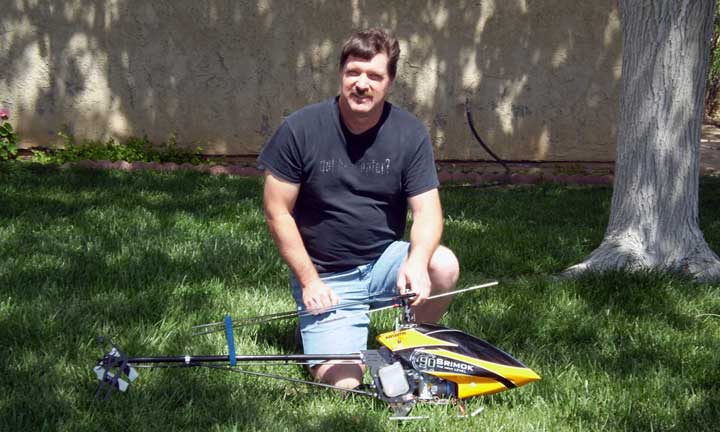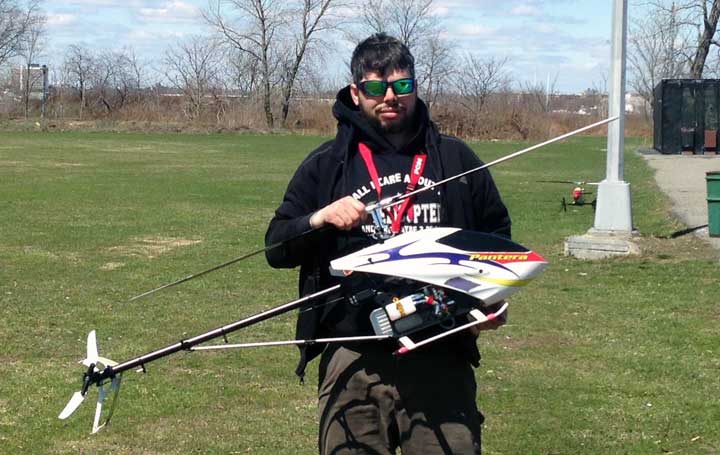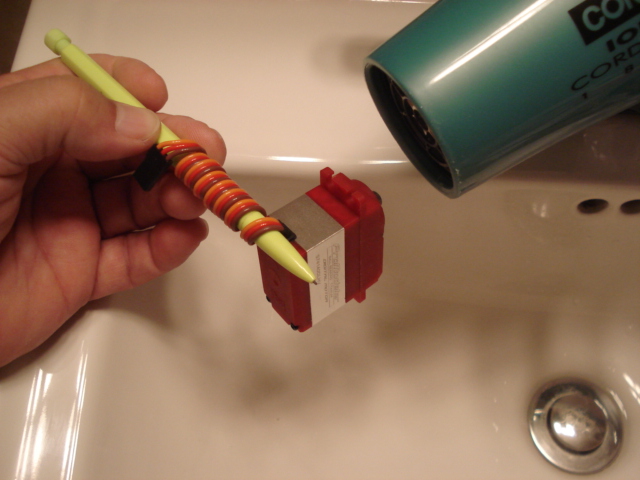Order this servo and receive a DS555BLHV - keep reading . . .
Note; we have deprecated the DS345BLHV after a long production run in favor of the DS555BLHV (555oz-in - 0.06sec/60°).
RECAP:
Developed
initially as a 245oz-in brushless servo for our lead non-civilian
client nearly a decade ago, ongoing iterative improvements saw it
achieve many firsts on its way to becoming the popular DS345BLHV. Things
like steel gears, bronze hard points in the aluminum, and conformal
coating on the PCB (permitting it to handle more torque and live longer
in high vibration environments) were first introduced in this, our top
of the range unit. And it led to gaining converts from other brands.
Meanwhile,
it's been unchanged for the last three years, but because our
competition never sleeps, then staying a step ahead of them means our
research never stops, either. While this led us to introduced both the DS630BLHV and DS930BLHV (at necessarily higher price points), so now we've
circled back around to the DS345 and have improved it yet again,
resulting in the DS555BLHV. The best part is, this time you get more torque.
Significantly more
torque. Enough to outclass many solid choices for 700-800=class 3D helicopters,
mid-size 3DXA models (105"), and 1/8th scale racing. Anyway, through the end of the calendar year, 12/2020 (giving
us time to create the DS55BLHV product listing), orders for the DS345
will be filled with the DS55BLHV (we're done making more DS345BLHV).
Bottom
line? The king is dead, long live the king . . . the DS55BLHV. So while
the DS345 is gone, please don't mourn it because this one's better!
And by the way, the fact it's stronger and faster means you can install
it on a 2-servo wing panel (one a DS470 and the other a DS55), or a 3-servo swashplate - and - never
notice a difference because it'll be a transparent match since it can
keep up with the old one in both torque and speed.
Moreover, you'll find the DS555BLHV is a worthy successor because we've retained all the good points that made the DS345 such a winner - like bronze hard points for the steel gear shafts, 13 o-rings for sealing, conformal coating of the PCB . . . and all whilst keeping costs in check!
DISCONTINUED: DS345BLHV
This is our top-of-the-range 345oz-in high voltage brushless servo created expressly for competition. Perfect for cyclic on 3D model helicopters, strong enough for 100cc IMAC models, and superb for 1/8th scale trucks, and so precise, it's ideal for use in jets. Is it any good? Well, of course . . . but what do you expect us to say? But please, don't take our word for it. Instead, listen to what competition pilots (not sponsored pilots who'll say what they're told), but real honest-to-God pilots - who pay for their own servos . . .

Mihai Aldea writes . . . "I'm very happy with
my choice of putting the ProModeler S245BLHV servos in the Goblin Speed. Not
only are they superlative performers, but the cost is unbeatable. I'm not
usually an early adopter of anything, but your record of common sense design and
customer service made this an equally common sense choice for me."
- Mihai Aldea, Issaquah, WA
Joe Meade
writes . . . "I decided to give these servos a try in my
Goblin 700 just over a year ago and I'm glad I did. Beautiful servos that
perform flawlessly, and at a fraction of the cost of similar servos. A quality
product that has performed without issue for over a year, these servos are
sweet, and I couldn't be happier. I can't imagine ProModeler servos will remain
a secret for long. I'm pretty sure these are what we call a
no-brainer."

- Joe Meade, Tram, KY
Jim Dyck
writes . . . "Just had to say thanks for making such a
great servo for such a reasonable price. I got these on my Kasama Srimok and
couldn't be more pleased. I like them so much I got a second set for another
heli. I really like how quiet (as in silent) they are, too. Will definitely be
getting more of these in the future."

- Jim Dyck, Ridgecrest, CA
Daniel Murnane writes . . . "I've been running the S245BLHV on one 700 for about a year now and have been very impressed with their performance and durability. This set has survived a rekit crash and is still going strong today. Since getting then I've put sets on another two helis."
- Daniel Murnane, Randallstown, MD
A man of few words, George Meccariello writes . . . "After 200 flights they're working great. No slop, no problems,
and being brushless they'll definitely last well beyond another 200
flights!"

- George Meccariello, Valley Stream, NY
Rob Nourse writes . . . "I have been flying the
ProModeler servos in my Logo 600 for about 5 months. They are absolutely
flawless cyclic performance. Quit looking, get these for your bird and I promise
you, these will be your new servos of choice."

- Rob Nourse, Springfield,
TN
And lest you think these servos are just for things, which fly . . . you're
right because 1/10th scale racing trucks can fly too! Like when they catch big
air off a table-top jump or while going through a series of whoops. That's
when they're being stressed as much or more than in a airplane or heli. Steering
duties for a racing truck requires a great deal of finesse from a fast and
strong servo, which centers great (especially when drifting through corners when
it's critical). What's more, durability is essential because you can win if you
don't finish.
Tim Braucht writes . . . I'm using the
S245BLHV for steering on a 1/10 4x4 short course truck I built to race. This
servo has been great and I couldn't ask for more. It's strong and
FAST!!!

- Tim Braucht, Wilmington, DE
Do you know the difference between coreless and brushless servos?
Don't get confused, what you want are brushless servos
. . . this really matters!
Marketing - some companies market servos specifically to
model helicopter pilots, giant scale modelers, robot-builders, or model car
drivers - as if servos knew in what they were being installed. This may explain
why reducing the servo-lead from 10" to 6", changing the part number, and
selling it as a truck-servo works in the minds of marketing-types. We don't play
those games because like you, we know what matters is a) whether the servo is
strong and fast enough for the job and, b) more important than anything, how
well it centers. If centering performance is what's important to you, you'll
appreciate knowing ProModeler servos use MIL-SPEC components because we
believe centering is the Holy Grail of servo design. While stick bangers don't
know the difference, centering is a big deal for pilots flying precision
maneuvers. This matters - period.
Advice - if you are unsure about the best servo for your
application, don't just take the advice of some anonymous 'expert' on a forum,
or buy whatever your buddy thinks is best. Instead, give us a call and ask
because we have the experience to help guide you. Best of all, our advice is
free (and worth every penny) and because we have a solid reputation for honesty
and offering common-sense no-bull answers, you can trust we won't sacrifice our
reputation just to upsell you on something a little bit more expensive.
Especially because we know that when you're happy, you'll tell a friend . . .
but if you're unhappy you'll tell everyone!
Bottom line? Reputations are earned and we value ours above merely making an
extra buck so go ahead and ask us.

- Pro Tip: Winding the lead and heating it for a few
seconds gives that clean professionally-installed look
At 347oz-in, the Hitec HSB-9370TH is a near match for the 345oz-in DS345BLHV. The Hitec is an immensely popular servo (meaning lots of folks at many flying fields have experience with it), and it's the subject of a competitive teardown. To begin, the HSB-9379TH is a very attractively finished servo due to its black plastic top and bottom case components combined with a red anodized aluminum center. They create an eye catching servo. Let's compare and contrast these two servos to see what we can learn.

Featuring a case, which is CNC-machined from a solid billet of aircraft aluminum, there's little doubt which is stronger and more durable. A case CNC-machined from a solid billet of 6061-T6 aircraft aluminum is the ultimate in protection and rigidity. The last is especially important when durability is a prime concern because a rigid case maintains geometry better under load. While ProModeler use a similar hybrid aluminum/plastic construction for less expensive servos, like our DS130DLHV which is offered for $29.99, the DS345BLHV is a our top of the line servo and thus, receives our best effort at providing good value. Moreover, note our use of 6 Allen head fine thread machine bolts for securing the transmission section (the upper case) to the center case. This, versus the Hitec method, which is assembled with 4 coarse screws - and note - these tap into the plastic upper case. However, not until after entering through the bottom cover (and passing clear through the aluminum section). Also, there are two smaller coarse screws (that also threaded into plastic, this time the upper-center section). Basically, while we assemble our components by individually securing them to the aluminum center section, they do clamp theirs together by threading into plastic. Our way costs more (and we feel it's stronger) but what matters is what you think is the better way to go.

Protecting the control electronics is important consideration during a crash. For this, our top of the line servo, we opt for an aluminum electronics cover (the bottom cover). While it's not really bullet proof, it's certainly going to protect things better than plastic. But what's important to notice in the above image is the grey silicone shock pad. While seemingly a simple component, It plays a key role in impact protection. And quite frankly, it doesn't cost very much which is why we were surprised to see our competition deemed it unnecessary. Then again, we're not building to a hobby-standard but to the far more demanding military-standard. While this may amount to a nothing burger for some, experienced modelers with an eye for detail always notice the little touches.

While it looks like the same picture, look again. In this one we've peeled back a corner of the shock pad to show you the the monkey snot on the board. Sure, some may think calling it monkey snot is gross, but the conformal coating on the PCB (printed circuit board) is a genuine improvement in the area of vibration protection. It's a dirty little secret of the electronics world but government regulations governing solder composition mean the good stuff from the good old days isn't legal for use. As a result, the use of a conformal coating has become of paramount importance in providing added reliability. Since models have a propulsion source, typically an electric motor or an engine vibration protection is an essential consideration. Whether it's an unbalanced prop, the pounding from the piston stroke, or the back straightaway of a rough race track, vibrations may destroy delicate electronic components. Monkey snot came about for the aerospace industry and migrated to military uses and into the best quality electronic products. It comes in various colors, black, white, clear, etc. but which color doesn't really matter as much as ensuring your servos are protected with the stuff. After all, you work hard for your money and ensuring your investment in a servo lasts (and more importantly, doesn't result in a senseless crash because a manufacturer took a shortcut) can be a big deal. Since the class of modeler using this level of servo is generally uncompromising in all things, making sure you get what you 'think' you're paying for is a big deal . . . especially if you're one of those for whom details matter.

So what's the big deal about using an aluminum cover instead of a plastic one to protect the PCB and the bottom of the motor? It matters - but only if you have something worth protecting. Note the four DIN912 machine thread bolts, complete with o-rings. These have an Allen head (hex) instead of a Phillips head (cross) and while they cost a little bit more, they are 'much' preferred by savvy modelers because they are just easier to use. Also notice the main o-rings - with our servo it's completely captured. This means totally hidden from view such that the odds of it being damaged are basically nil. Meanwhile, our esteemed competitor's main o-ring is exposed (visible) on all four sides - believe it or not! This puts your servo (and thus, your model) at risk if it's inadvertently nicked. Some would say this has to do with reducing costs but we won't presume to judge preferring to leave that to you.